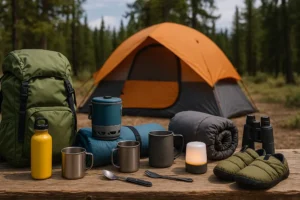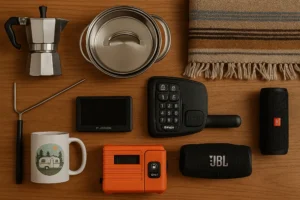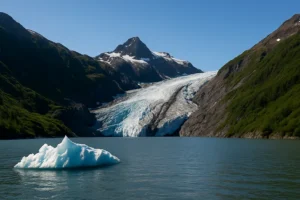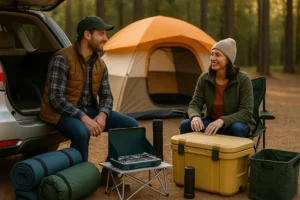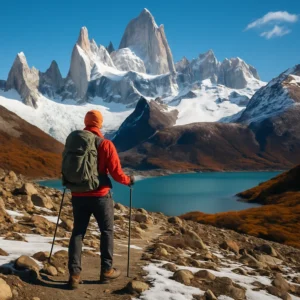There’s something magical about sitting around a fire when you’re out in the wild. The warmth, the glow, the comfort—it’s what camping dreams are made of. But what happens when the rain comes down and your only wood supply is damp or downright soaked? If you’ve ever struggled with soggy logs and frustration, you’re not alone. The good news is that learning how to start a fire with wet wood isn’t impossible. In fact, it’s one of the most important outdoor skills you can master. With the right knowledge, a bit of patience, and the right preparation, you’ll never have to sit shivering in the rain again.
Understanding Why Wet Wood Is a Challenge
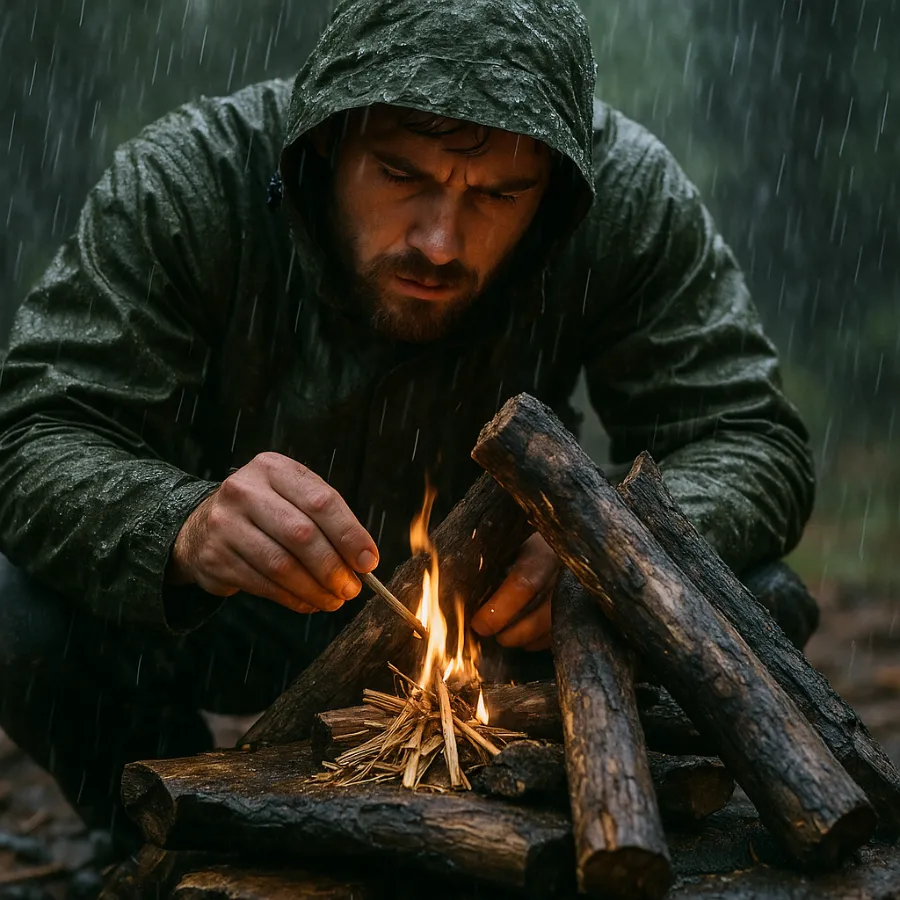
Before diving into techniques, let’s talk about the science behind wet wood. Freshly fallen rain or damp ground means one thing: moisture. And when water soaks into wood fibers, it fights combustion. Instead of catching fire, wet wood tends to hiss, smoke, and sputter. The flame struggles, and instead of crackling logs, you’re left with billowing smoke and a weak glow.
Moisture not only slows ignition but also saps heat away from your fire. The energy that should be used for flames is wasted on evaporating water. That’s why patience and preparation matter when dealing with wet wood—you’re fighting water as much as you’re building fire.
Essential Materials You’ll Need
To beat wet wood, you need the right setup. Think of fire-building as a recipe: the ingredients matter just as much as the method.
- Tinder
This is your spark catcher. Dryer lint, cotton balls coated with petroleum jelly, dry grass, shredded bark, pine needles, or birch bark are all excellent options. When it’s wet out, carry tinder with you. A small baggie of dryer lint or cotton balls in your backpack can save the day. - Kindling
Small twigs, wood shavings, or split sticks (about the width of a pencil) will bridge the gap between your tinder and firewood. In wet conditions, you’ll need much more than usual—plan on three to four times more kindling than for a dry fire. - Firewood
Larger branches and logs form the backbone of your fire. If everything is wet, don’t panic—split logs open to expose the drier inner wood. Avoid green wood (freshly cut) since it’s full of water and produces nothing but smoke. - Fire starters
Matches, lighters, waterproof matches, or a flint striker all work. Chemical fire starters, wax cubes, or even cotton balls in petroleum jelly can give you a longer-lasting flame to dry out damp wood. - Tools (optional but helpful)
A hatchet, knife, folding saw, or even a shovel can make the job easier. Splitting wood, shaving tinder, and building a platform becomes much simpler when you have the right gear.
Preparing Your Fire Site
When it’s wet outside, where you build your fire matters just as much as how you build it.
- Find shelter: Look for natural cover such as a rock overhang, the base of a large fallen tree, or a dense tree canopy.
- Avoid fire pits that collect water: Many designated fire pits are depressions, which makes them natural puddles in the rain. If it’s soaked, build your fire on a raised platform.
- Use rocks, bark, or a log base: Keeping your tinder and kindling off the damp ground is crucial. A dry foundation keeps your fire breathing and helps insulate against moisture.
- Safety first: Always check if fires are permitted in the area. Follow Leave No Trace principles and have water or dirt nearby to put the fire out if needed.
Building the Fire Structure
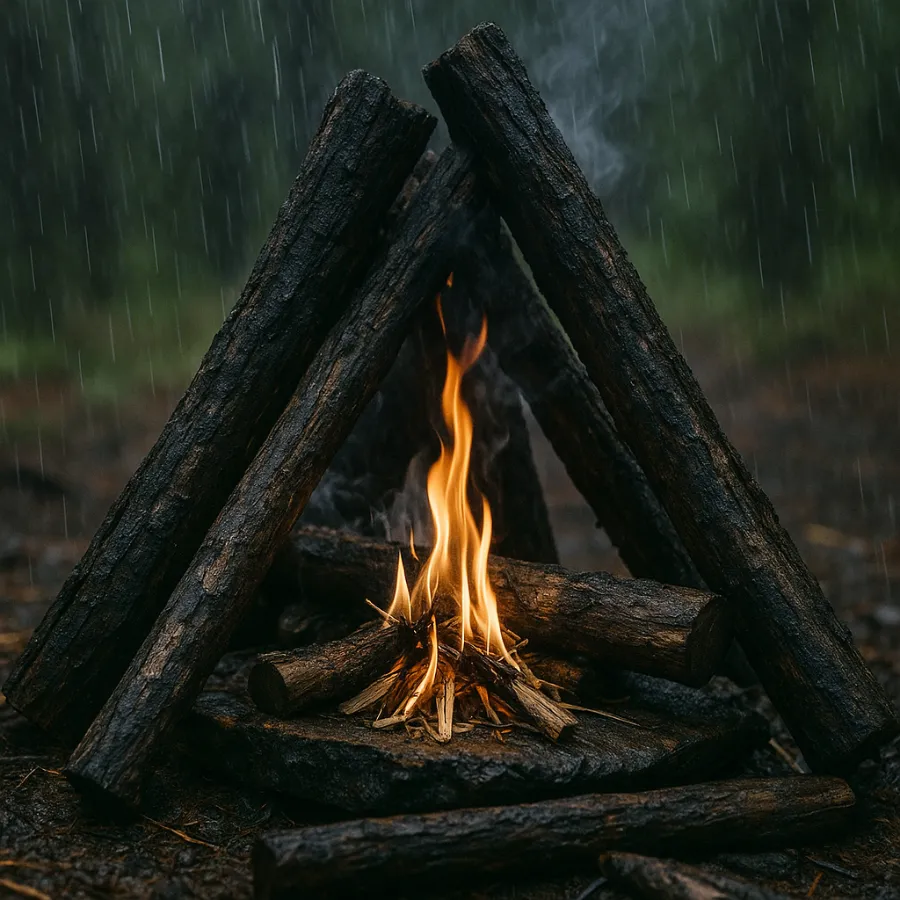
There’s no one right way to stack a fire, but some methods work better in damp conditions.
Teepee Fire
The classic. Build a small teepee of tinder and kindling, then surround it with larger sticks and logs in the same formation. This allows flames to rise naturally and air to flow in.
Lean-To Fire
Useful in breezy conditions. Place a larger log at an angle, then lean tinder and kindling against it, building upward. The log acts as a windbreak while still allowing airflow.
Criss-Cross (Log Cabin) Fire
Stack logs in alternating layers like Lincoln Logs, leaving space in the center for tinder and kindling. This structure creates airflow and allows for steady heat to build up.
Step-by-Step: How to Start a Fire with Wet Wood
Now let’s put it all together. Here’s a methodical approach to building fire in less-than-ideal conditions:
- Gather extra tinder and kindling
Wet wood requires more heat to catch. Collect three to four times the normal amount. - Split your logs
Even soaked wood is usually drier on the inside. Use a hatchet or strong knife to split branches and expose the dry core. - Create a platform
Lay down a foundation of bark, rocks, or dry sticks to keep your tinder off wet ground. - Build your fire structure
Choose teepee, lean-to, or criss-cross and arrange your materials for maximum airflow. - Light your tinder in multiple places
Don’t rely on a single spark. Light your tinder from different angles to give it the best chance. - Add kindling gradually
Once tinder catches, feed small dry twigs to build heat. Avoid piling too much too fast—it will smother the flame. - Introduce larger wood slowly
Once flames are steady, start adding split logs and thicker sticks. Keep wet logs close to the fire’s edge so they begin drying out for later use. - Maintain airflow
If the flames start to die, gently blow near the base or use a stick to adjust the wood. Oxygen is fuel. - Build embers
Your goal isn’t a giant blaze but a steady bed of glowing embers. Once you have that, sustaining the fire becomes much easier.
Tips and Tricks for Success
- Collect tinder as you hike: Even in rain, look under logs, dense foliage, or inside dead trees for dry material.
- Look up, not down: Fallen wood on the ground is usually soaked. Dead branches caught in trees often stay dry inside.
- Use natural fire helpers: Pine resin, fatwood, or birch bark are excellent accelerants. They burn hot and long even when damp.
- Dry as you burn: Place wet logs around the perimeter of your fire. The heat will slowly evaporate moisture, making them usable later.
- Think redundancy: Always carry multiple fire-starting tools. Matches can get wet, but a lighter and a flint rod won’t fail together.
Safety Considerations
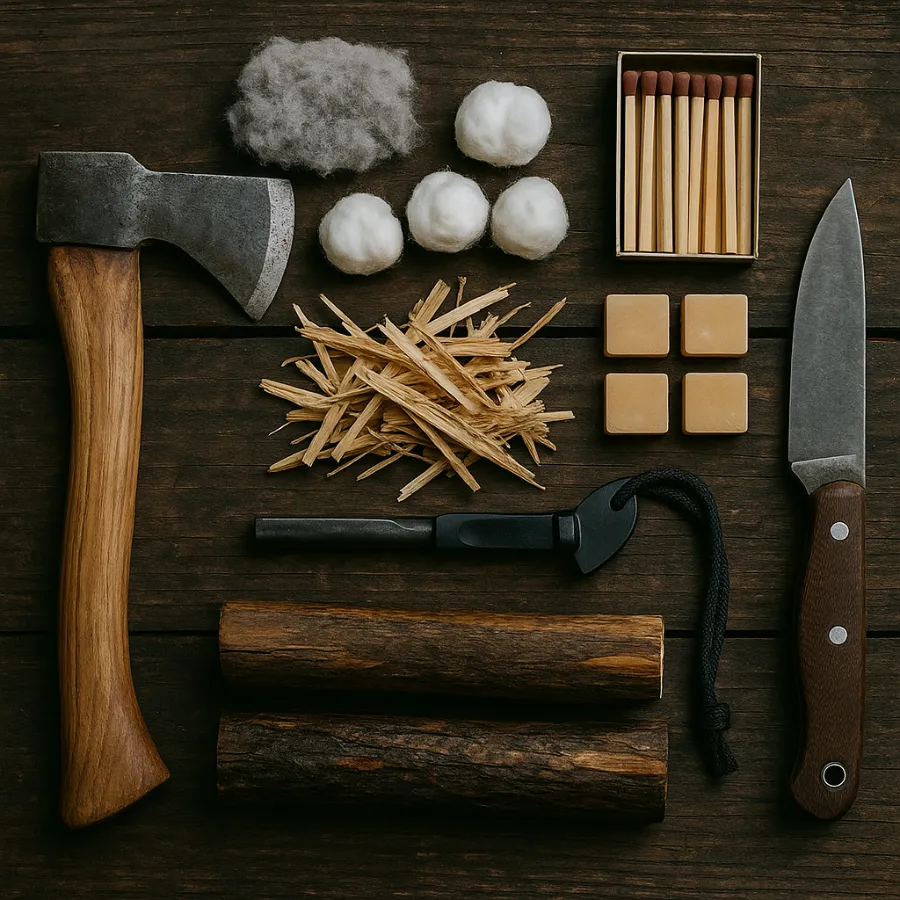
Starting a fire in wet conditions can make you desperate for shortcuts—but some are dangerous.
- Never use gasoline or lighter fluid. It’s unpredictable and dangerous.
- Keep flames under control. Remember that sparks can travel far, especially in the wind.
- Always extinguish your fire completely before leaving. Sprinkle with water, stir the ashes, and feel with your hand to check for heat.
Conclusion
Learning how to start a fire with wet wood is more than a camping trick—it’s a survival skill. It’s about preparation, resourcefulness, and patience. With a little practice, you’ll discover that even the dampest logs can produce a roaring, comforting blaze. So next time the rain soaks your campsite, don’t pack it in. Use the techniques here, take your time, and prove that a little water won’t keep you from enjoying the warmth of the fire.




